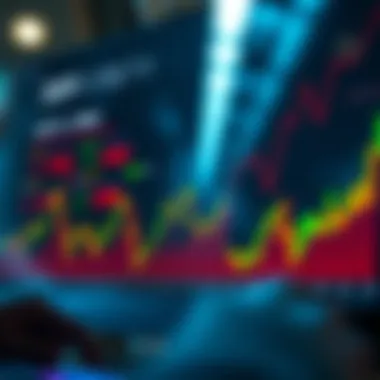DeFi Stock Predictions: Future of Decentralized Finance


Intro
As the financial world continues to pivot towards innovation, decentralized finance, commonly referred to as DeFi, stands at the forefront of this evolution. DeFi presents an array of opportunities that promise to reshape traditional finance by eliminating intermediaries. This transformation brings both an exciting landscape for investors and certain risks that must be navigated carefully.
In this piece, we aim to dissect the intricacies surrounding DeFi stocks, guided by ongoing market trends, technological breakthroughs, and vital expert opinions. By leveraging a mix of quantitative insights with qualitative assessments, this article aspires to equip investors and tech enthusiasts alike with a well-rounded understanding of a sector that is rapidly changing.
Understanding Cryptocurrency
Being well-versed in cryptocurrency is essential not only for participating in DeFi but for grasping its broader implications on finance. As we peel back the layers of digital currencies, one can appreciate their underlying mechanisms and contributions to this new financial era.
What is Cryptocurrency?
Cryptocurrency is, at its core, a digital or virtual form of currency that utilizes cryptography for security. Unlike traditional currencies issued by governments, these digital coins operate on decentralized networks based on blockchain technology. Each transaction is recorded on a public ledger, ensuring transparency and security while reducing the potential for fraud.
Importantly, cryptocurrency is not just a fad; it is an idea born out of the need for a system that offers secure, anonymous transactions. Bitcoin, the trailblazer of cryptocurrencies, paved the way for thousands of other coins, each with its unique proposition. From Ethereum, which enables smart contracts, to stablecoins' pegged value, the diversity is profound.
Key Components of Cryptocurrency
Understanding cryptocurrencies involves familiarizing oneself with a few key components:
- Blockchain Technology: The backbone of cryptocurrencies, it acts as a decentralized public ledger that records all transactions.
- Wallets: Digital wallets allow users to store, send, and receive cryptographic assets securely.
- Smart Contracts: These self-executing contracts with the terms of the agreement directly written into code enable decentralized applications.
- Mining and Staking: Mining involves validating transactions and maintaining the blockchain, while staking refers to holding a certain amount of a cryptocurrency to support network operations.
To dig deeper into cryptocurrency, you can visit Wikipedia's Cryptocurrency page.
Navigating the Market
With a clear understanding of cryptocurrency, let's navigate the developing DeFi market. Embracing change while knowing the tools to invest wisely in this realm is critical for success.
Investment Strategies and Tips
Investing in DeFi stocks demands a different approach compared to traditional investments. Here are some strategies and tips to consider:
- Diversify Your Portfolio: Avoid putting all your eggs in one basket. Explore various DeFi projects to minimize risks.
- Research Thoroughly: Look into the team behind the project, their roadmap, and community engagement. Good projects usually have strong developer support and a solid user base.
- Stay Updated: Follow industry news and stay abreast of regulatory changes that may impact the DeFi landscape.
- Use Trusted Exchanges: Ensure that you trade on reliable exchanges with established security measures.
- Assess Risks: Understand that the DeFi space can be highly volatile and prone to market swings. Assess your risk tolerance before diving in.
Analyzing Market Trends
The DeFi landscape is fluid, with trends shifting as new technologies and regulatory frameworks emerge. Keeping an eye on trends can position investors to anticipate changes.
- Growing Number of DeFi Projects: The rise in the number of projects indicate robust interest, leading to innovations in services like lending, borrowing, and yield farming.
- Institutional Interest: Large financial institutions showing interest in DeFi could signal maturity in the field, likely attracting more investors.
- Cross-Chain Solutions: Technologies that allow interoperability among different blockchains can enhance liquidity and provide users with a broader array of options.
Keeping a pulse on market trends is crucial. You may want to explore platforms like Reddit for community insights or Investopedia for educational resources.
“The future of finance is decentralized. Understanding its components is not just advisable; it's essential for any serious investor.”
As we step further into this journey of understanding DeFi stocks, insights from market analyses and predicting future trends will be vital for anyone looking to invest wisely.
Understanding DeFi: An Overview
In the realm of finance today, a significant shift is occurring with the rise of decentralized finance—or DeFi. Understanding this movement is crucial, not just for tech enthusiasts or investors, but for anyone interested in the future of finance and its implications on society. DeFi represents a breakaway from traditional financial systems, offering new opportunities and challenges alike. By delving into its core aspects, we can better navigate this rapidly changing landscape.
Decentralized finance encompasses a variety of financial services such as lending, borrowing, and trading, without the need for intermediaries like banks or brokers. This democratization allows individuals to engage directly in financial activities, promoting greater inclusivity. However, this comes with its own set of considerations, like security risks and regulatory uncertainty.
What is Decentralized Finance?


Decentralized finance is the application of blockchain technology to recreate and enhance traditional financial systems. In straightforward terms, it allows people to perform financial transactions like buying, trading, or lending money without central authorities. This not only lowers costs but also increases accessibility by providing financial services to those who are unbanked or underbanked.
DeFi platforms commonly use blockchain protocols such as Ethereum, enabling transactions through smart contracts—these are self-executing contracts that automatically enforce agreements when certain conditions are met. Decentralized finance is rapidly gaining traction, potentially reshaping how we perceive and engage with money and banking.
Key Concepts in DeFi
Understanding the foundational elements of DeFi is critical. Here, we discuss three pivotal concepts: Smart Contracts, Liquidity Pools, and Yield Farming.
Smart Contracts
Smart contracts are at the heart of the DeFi ecosystem. They are programmed agreements that automatically execute actions when predetermined conditions are met. This eliminates the need for trust between parties; the code itself enforces compliance.
A notable characteristic is their transparency. Once a smart contract deploys on the blockchain, it’s publicly accessible, allowing anyone to verify its authenticity. This feature enhances trust and reliability, making them a valuable choice for secure transactions in DeFi.
However, they come with technical complexities. Coding errors or vulnerabilities can lead to significant financial losses, as seen in some recent exploits. Therefore, while smart contracts offer efficiency and safety, they demand rigorous testing and auditing.
Liquidity Pools
Liquidity pools are another cornerstone of DeFi platforms. They serve as reserves of tokens locked in smart contracts, enabling transactions. They operate on the premise of community contributions—users provide funds to these pools, where liquidity is then accessible for trading and lending.
The unique aspect is the ability for users to earn returns on their contributions. Unlike traditional banks, where depositors earn minimal interest, liquidity providers can receive significant yields, fueled by transaction fees and incentives. Yet, this comes with potential risks; impermanent loss can occur if market prices fluctuate dramatically.
Yield Farming
Yield farming refers to the practice of earning interest on cryptocurrency holdings by lending or staking them in various DeFi protocols. This concept has surged in popularity, with many investors drawn to its potential for high returns compared to traditional saving methods.
The defining feature of yield farming is its flexibility. Users can move their assets between different platforms to maximize gains, adapting to market conditions. However, it requires careful monitoring and can be risky. In some cases, yields can drop significantly or APIs can be altered unexpectedly, which may lead to losses if not managed prudently.
In summary, these key concepts form the bedrock of decentralized finance. They illustrate how DeFi operates while highlighting its potential benefits and pitfalls. Understanding DeFi not only empowers investors but also informs broader discussions on innovative financial practices in the future.
The transition to decentralized finance signifies a leap toward a more accessible global financial system, though it carries its own complexities and risks. This balancing act will be crucial as individuals navigate their investment decisions.
The Evolution of DeFi Stocks
The journey of decentralized finance (DeFi) stocks is both complex and fascinating. It’s vital to comprehend the evolution of these stocks to understand their current and potential impact on the finance ecosystem. This section will explore how DeFi stocks have developed over time, the lessons learned from past investments, and how the landscape is being shaped today.
Historical Context of DeFi Investments
Looking back, the seeds of DeFi investments were sown with the inception of Bitcoin in 2009. Initially considered a novelty, cryptocurrencies gradually found a foothold within the financial markets. With the development of Ethereum in 2015, the framework for smart contracts was introduced. This marked a significant shift, as it laid the ground for various DeFi applications to emerge.
DeFi's early years, however, were not without their challenges. Projects like The DAO, which aimed to create a venture capital fund on the Ethereum blockchain, faced significant failures, leading to issues regarding security and public trust. The hard fork that resulted in Ethereum and Ethereum Classic underscored the risks tied to such investments. Investors learned the hard way that due diligence was crucial.
In the subsequent years, platforms like Uniswap and Compound began catching investor's attention by solving liquidity issues and offering yield farming opportunities. The surge in popularity demonstrated that not only could DeFi offer innovative financial solutions, but it also attracted a new class of investors keen on exploring opportunities beyond traditional finance.
Current Market Landscape
Today, the DeFi market is an intricate web of applications and instruments, each vying for attention. As of now, several key players dominate the landscape. Projects such as Aave, SushiSwap, and Maker have built substantial ecosystems that cater to various aspects of finance—borrowing, lending, and trading, just to name a few.
The current market landscape showcases a blend of traditional financial principles with cutting-edge technology. The Total Value Locked (TVL) metric has become a focal point for gauging the health and adoption of DeFi platforms. Just a few years ago, TVL was a mere whisper on the lips of investors, but it now stands as a beacon, illustrating where trust and capital are pooled.
The rapid growth of DeFi stocks emphasizes the necessity for investors to keep their fingers on the pulse of technological advancements and market sentiment.
Community involvement and governance models have also shifted the dynamics of investment. Many DeFi projects operate on a community-driven governance model, where stakeholders can vote on crucial decisions. This ingenuity allows for a more democratic approach to financial services, aligning the interests of users and builders.


While the innovation is exhilarating, it also comes with its share of ambiguity. Regulatory oversight is gradually tightening, as governments worldwide seek to catch up with an evolving financial ecosystem. The volatility inherent to cryptocurrencies remains a noteworthy challenge for investors, making it crucial to tread carefully. Investments in DeFi stocks, therefore, must be approached with a mix of optimism and caution, armed with a keen understanding of both the history and current conditions of the market.
Factors Influencing DeFi Stock Predictions
In the fast-paced world of decentralized finance (DeFi), the landscape is not just shaped by innovations in technology and market demand, but also by a host of other factors that bear weight on stock predictions. Understanding these influences is paramount for investors wanting to navigate this intricate terrain. Key elements, from market trends to advancements in technology, provoke changes that can boost or dampen the enthusiasm surrounding specific stocks. An informed investor can gain a competitive edge by keeping a finger on the pulse of these factors while crafting balanced predictions.
Market Trends to Monitor
Token Performance
Token performance is a cornerstone of stock predictions in the DeFi space. A token's price movement often reflects a multitude of underlying factors, such as the overall market sentiment, adoption rate among users, and the effectiveness of the project's utility. Strong token performance instills confidence among investors, making them more likely to engage with and invest in the associated projects.
Statistically, tokens with higher liquidity tend to show more stability in price, which is essential for those wary of the less predictable nature of cryptocurrency markets. However, past performance does not guarantee future gains. For instance, despite a robust earlier performance, market corrections can quickly realign expectations.
The key characteristic here is the volatility associated with tokens, which can be a double-edged sword. On one hand, the potential for high returns can be enormous; on the other hand, the risks involved can turn unfavorable in a blink. This dual nature keeps investors on their toes, necessitating constant market monitoring.
Regulatory Developments
Regulatory developments play a pivotal role in shaping the future of DeFi stocks. They can act as a beacon for safety or, conversely, as a storm cloud warning of impending challenges. When governments introduce clearer guidelines or policies about DeFi operations, it often leads to heightened investor confidence. For example, regions that have embraced DeFi through friendly regulations see more capital flow into these markets.
However, shifting regulations can also lead to uncertainty. A sudden legislative move can result in sharp price swings or reduced trading volumes for certain tokens. Thus, being tuned into the regulatory environment can offer predictive insights for investors. Following ongoing discussions in legislative corridors, such as the latest on stablecoin regulations from entities like the U.S. SEC or the European Securities and Markets Authority, proves to be immensely beneficial.
Technological Innovations
Layer Two Solutions
Layer Two Solutions have emerged as game-changers in the DeFi ecosystem. They address the inherent scalability issues faced by many blockchain platforms, enabling faster transactions and lower fees. Such advantages are invaluable for projects that deal with high transaction volumes, like those involved in decentralized exchanges. The reduction in congestion translates into smoother operations and enhanced user experience—an aspect that significantly attracts investors.
This characteristic makes Layer Two Solutions highly appealing. However, they are not without their challenges. Integration with existing systems can prove complex, and some may question the security of solutions placed atop Layer One chains. Investors must weigh these pros and cons when assessing potential investments.
Cross-Chain Compatibility
Cross-Chain Compatibility is increasingly seen as a vital aspect of the DeFi evolution. The ability to facilitate transactions across different blockchain networks fosters a more interconnected ecosystem, which can significantly enhance liquidity and broaden user engagement. When platforms embrace cross-chain capabilities, they tap into wider markets, gaining exposure that can positively influence their stock value.
This attribute stands out as it promotes innovation and user choice among various blockchains and ecosystems. However, the technology involved can be both costly and complex to implement, possibly leading to compatibility issues. Investors should take care to analyze the project's roadmap for cross-chain functionalities, as smooth integration can lead to greater market adaptability.
Community and Governance Dynamics
The strength of community engagement and governance in DeFi projects cannot be understated. Active participation and transparent governance mechanisms often correlate with a project's success. Token holders who are involved and can influence decisions find greater satisfaction from their investments. It's an organic factor quite unlike traditional stock markets, where shareholder voices can be muted. In DeFi, the community may hold the keys to robust project health, making it an interesting angle for future predictions.
Understanding the motivations of community members and how decisions are made in governance brings clarity to how stocks could fare in the volatile DeFi landscape. Investors should observe governance models—whether centralized or decentralized—as they can directly impact how well the project adapts to changes in the industry.
Analytical Techniques for Prediction
Understanding how to predict the performance of decentralized finance (DeFi) stocks is akin to finding a needle in a haystack. In this intricate world where technology meets finance, analytical techniques serve as powerful tools for gauging potential opportunities and risks. Employing a variety of analytical methodologies not only enhances the capability to forecast market movements but also equips investors with a multi-faceted view of the evolving DeFi landscape. In this section, we will dive into both quantitative and qualitative analysis that paves the road for forecasting DeFi stock trajectories effectively.
Quantitative Analysis
Technical Indicators
Technical indicators occupy a central place in the toolkit of any astute investor. These mathematical computations drawn from market data, typically price and volume, help in identifying trends and market conditions. One key characteristic of technical indicators is their ability to distill complex market movements into simple visual charts, aiding investors in making quick decisions. This makes it a beneficial choice for readers seeking to navigate through the flux of DeFi stocks.
A unique feature of technical indicators is their adaptability across different time frames. For instance, whether you’re trading on a daily, weekly, or monthly basis, indicators like Moving Averages or Relative Strength Index provide valuable insights irrespective of the chosen timeframe. While they do come with certain disadvantages—such as lagging during fast-moving markets—they encourage informed decision-making, especially when utilized alongside fundamental analysis.


Market Sentiment Analysis
Shifting gears to market sentiment analysis, this method emphasizes the psychological aspects of trading. Unlike statistics that derive insights purely from numerical data, sentiment analysis taps into the emotions and perceptions influencing the market. A key characteristic here is its timely feedback on trader attitudes towards specific coins or platforms. This characteristic makes it a popular choice among investors who understand that market sentiment often dictates short-term price fluctuations.
A unique strength of market sentiment analysis lies in its adaptability. With social media platforms like Reddit or Twitter buzzing with discussions about DeFi projects, tracking sentiment can provide a near real-time look into community confidence. However, investors must exercise caution; sentiment can quickly turn, leading to potential panic selling or buying sprees that do not always align with fundamental performance. This duality—offering both insights and volatility—should be factored into risk assessments.
Qualitative Analysis
Expert Opinions
Now, let’s pivot to qualitative analysis where expert opinions shine a bright light on the intricate world of DeFi. Leveraging the insights of seasoned professionals can yield a more profound understanding of market dynamics. The key characteristic of expert opinions is their ability to encapsulate qualitative data through the lens of experience and expertise, thus providing a richer context to numerical analyses. This is notably a beneficial angle in an industry that is still nascent and evolving rapidly.
Many industry experts bring with them years of knowledge, navigating through the ups and downs of financial trends. Their foresight can be invaluable, although it’s essential to remember that even experts can miss the mark. This unpredictability highlights the unique feature of expert opinions—they are often subjective and can vary widely. This presents both an advantage and a limitation; while they can offer diverse perspectives, conflicting opinions may also lead to confusion among investors. Hence, synthesizing multiple expert viewpoints is advisable.
Industry Reports
Finally, industry reports serve as a cornerstone of qualitative analysis. These comprehensive documents assembled by research groups or think tanks provide in-depth knowledge about current trends, forecasts, and challenges faced by the DeFi ecosystem. A key characteristic of these reports is the robustness of their data, making them a trustworthy source for investors attempting to cut through the noise of the market.
Reports often include rigorous methodologies and a wide-ranging analysis of case studies and market drivers. They also dissect regulatory landscapes which are paramount in DeFi investments. However, the drawback can be their timeliness; industry reports may become outdated due to the lightning-fast pace of technological advancements in DeFi. Thus, it’s prudent for investors to not solely rely on these reports but to combine findings from multiple sources, ensuring a holistic view of the landscape.
"In the realm of investments, understanding the blend of quantitative data with qualitative insights is crucial for informed decision-making."
By mastering both analytical techniques, investors can better navigate the future of decentralized finance stocks, grounded on informed decisions rather than mere speculation.
Challenges in DeFi Investments
In the ever-evolving realm of decentralized finance (DeFi), investors face a labyrinth of challenges that could impact their ventures significantly. Understanding these hurdles is essential for anyone looking to navigate the turbulent waters of DeFi stocks effectively. The unpredictability that defines this sector necessitates a cautious and informed approach, ensuring that investors are not just riding the wave but also prepared for potential storms. Grasping the challenges inherent in DeFi investments allows stakeholders to make more strategic choices, ultimately fostering a more resilient investment practice.
Volatility and Risk Assessment
DeFi markets are notorious for their wild price swings. Even seasoned investors can find themselves feeling like they are on a roller coaster. The volatility can arise from various factors, including market sentiment, regulatory news, or even the performance of layer one blockchain platforms. While this presents opportunities for profit, it also escalates risk.
To assess volatility accurately, investors need to familiarize themselves with several methods:
- Historical Data Analysis: Examining past performance of tokens can provide insights into their behavior during market downturns. This could help in anticipating future movements.
- Volatility Indices: Platforms like the Crypto Volatility Index (CVI) track price movements and can serve as a helpful tool to gauge market stability.
The importance of risk assessment cannot be overemphasized. Investors must ask themselves: How much are they willing to lose? Have they implemented proper risk management strategies, such as stop-loss orders or portfolio diversification? Tackling these questions is integral to mitigating potential downsides.
Security Concerns
Security in the DeFi landscape isn't merely a concern; it's the bedrock upon which trust is built. With the decentralized nature of these platforms comes an attractive pitch: self-custody of assets. However, with great power comes great responsibility. Security breaches can lead to catastrophic losses.
There are several key security concerns that investors should keep in mind:
- Smart Contracts Vulnerabilities: A poorly coded smart contract can serve as an open door for hackers. Before investing in a DeFi project, it's prudent to check if the platform has undergone thorough security audits.
- Phishing Attacks: The decentralized nature doesn’t shield investors from classic scams. Phishing remains prevalent, with attackers impersonating platforms to steal assets. Investors should always double-check URLs and use official platforms.
- Network Risks: Even strong platforms can face network congestion or glitches that may hinder transactions. Having contingency plans, such as emergency exits or alternate trading platforms, can provide additional security.
"As much as DeFi offers a world of opportunities, it equally comes wrapped in layers of complexities and risks. Knowledge is your best shield against threats."
Addressing these concerns is non-negotiable. Investors must cultivate security awareness and remain vigilant as the DeFi ecosystem matures. The landscape is unpredictable, but understanding potential risks can empower investors to navigate it more effectively.
Future Outlook for DeFi Stocks
The future of DeFi stocks is particularly pertinent in today’s market landscape, where innovation continually reshapes financial paradigms. Understanding where these investments are headed offers significant advantages. As decentralized finance becomes more sophisticated, captureing the intricacies of market movements and the adopted technologies can turn the tide for investors. Key elements will include the adoption of blockchain technology, regulatory influences, and market sentiment, all of which will play pivotal roles moving forward.
One could argue that the transformative nature of DeFi, which operates beyond traditional financial institutions, makes it ripe for growth. Therefore, weighing the pros and cons is crucial for any potential investor intending to navigate this evolving terrain. Investors need to be mindful of various factors:
- Innovative Products: With advancements in yield farming and liquidity pools, the investment avenues are expanding.
- Regulatory Frameworks: The legal landscape will dictate how platforms operate, which can significantly affect stock performance.
- Market Trends: Sentiment and technological shifts often drive the market bus.
Given the rapid changes, this section will delve into both short and long-term predictions, highlighting necessary strategic recommendations to enhance investment approaches.















